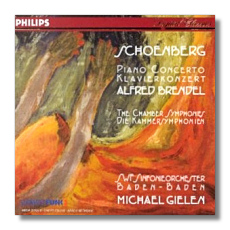
The Internet's Premier Classical Music Source
Related Links
- Schoenberg Reviews
- Latest Reviews
- More Reviews
-
By Composer
-
Collections
DVD & Blu-ray
Books
Concert Reviews
Articles/Interviews
Software
Audio
Search Amazon
Recommended Links
Site News
 CD Review
CD Review
Arnold Schoenberg

- Concerto for Piano and Orchestra
- Chamber Symphony #1
- Chamber Symphony #2
Alfred Brendel, piano
SWF Symphony Orchestra Baden-Baden/Michael Gielen
Philips 446683-2 60:59
Whenever I hear Arnold Schoenberg's Chamber Concerto #1, I feel as if I am watching an exotic insect burst from its chrysalis. The old casing is there, but there is new movement. This concerto has post-romantic melodies that hearken back to his Verklärte Nacht (1899). Yet the jaunty, intrusive horns in the scherzo are messages from the future. At first it's difficult to discern what he is doing in the slow movement, with its rising fourths, six-note woodwind chords, and clarinet arpeggios. Not until the finale, in which he recapitulates and transforms earlier themes, is his design clear. He is playing tug-of-war with the past, negotiating with it, and transforming it. The results, as played by Michael Gielen, have their plusses and minuses. On one hand, Gielen preserves the piece's nervy, edgy sound. (Stravinsky called the composition "neurasthenic."). On the other, he gives more weight to its modernistic elements and tends to mute the older, melancholy ones. It is still a good performance of this vibrant, aggressive, and impassioned work. Such a pity so few conductors perform it in repertoire.
Schoenberg began his Chamber Symphony #2 shortly after #1, but completed it thirty years later. In this piece, he continues to try new harmonic inventions, combining dissonance with traditional tonal effects. Yet unlike in #1, he takes time to develop his themes. Musically, it may be a superior piece, with more logical coherence and clearly-defined development; historically, it is a throwback to his neo-tonal techniques. Schoenberg apparently felt he had to offset the severity of his dodecaphonic compositions with others in a more traditional manner. Yet it is clearly a document of its times. Gone is the tension between old and new, and in its place is a shocking descent from woodwind airiness to the despondence of brass and strings. World War II was just beginning and the gloomy Lento that concludes this piece undoubtedly reflected it. A version by the New Philharmonia Orchestra's Frederick Prausnitz (EMI Classics, Matrix 25) is both livelier in the Con fuoco and more shattering in the Lento. Prausnitz also shaves a minute from Gielen's rendition. The concluding bars in Prausnitz's version sent a chill through me, while those in Gielen's were well-executed, but strangely bloodless.
Schoenberg's only Piano Concerto is even more of a war piece than Chamber Concerto #2. He subtitled its four movements for Oscar Levant (who originally commissioned the work but withdrew). They are titled – somewhat enigmatically – "Life was so easy," "Suddenly hatred broke out," "A grave situation was created," and "But life goes on." Pianist Alfred Brendel seems puzzled by this music, especially the pathos required in the Adagio. In the liner notes he claims the piece has "less than perfect notations" and "warts." He plays the six-tone patterns (broken into chords of three tones) choppily; if he were a painter, they'd be shards in a second-rate cubist painting. I prefer the kinder and gentler 1961 Glenn Gould's interpretation (Sony SM2K52664). Compare the last minute of its Adagio to Brendel's. Gould plays softly with even a bit of rubato; Brendel attacks virtuoso-style, muting the poignance. During the Giocoso movement, Gielen's brass blares too frequently, while conductor Robert Craft integrates it seamlessly with Gould's playing. Gielen's string crescendos often rise and fade faster than the ear can absorb them and the last jarring chords close too suddenly. Rather than "life goes on," you feel that life is suddenly cut short. Yet Gould and Craft are more restrained, creating a finale with more subtle resolution. Brendel's interpretation, although it clearly struggles with the music, is not completely wrong. It has its exciting moments and is even dazzling at times. Purchase it if you'd like second copy for your collection, just for contrast.
Copyright © 1999, Peter Bates



















